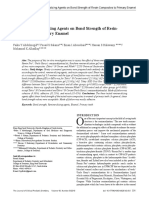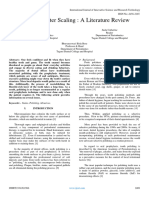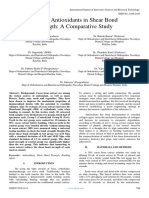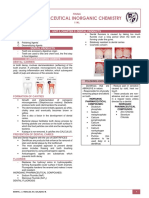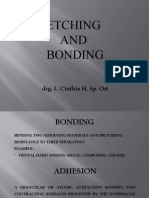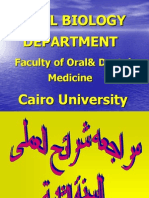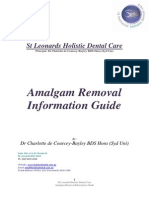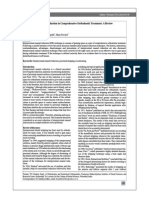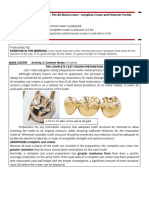Professional Documents
Culture Documents
CPP-ACP in The Treatment of Hyper Sensitivity Associated With Vital Tooth Bleaching A Systematic Review
Original Title
Copyright
Available Formats
Share this document
Did you find this document useful?
Is this content inappropriate?
Report this DocumentCopyright:
Available Formats
CPP-ACP in The Treatment of Hyper Sensitivity Associated With Vital Tooth Bleaching A Systematic Review
Copyright:
Available Formats
Volume 7, Issue 6, June – 2022 International Journal of Innovative Science and Research Technology
ISSN No:-2456-2165
CPP-ACP in the Treatment of Hyper Sensitivity
Associated with Vital Tooth Bleaching:
A Systematic Review
Pratyusha Giri Sathiyapriya S, Sindhu R., Bharathwaj V. V.
Undergraduate student, Senior Lecturer, Department of Public Health Dentistry,
SRM dental college, Ramapuram, Chennai, India SRM dental college, Ramapuram, Chennai, India
Dinesh Dhamodhar, Rajmohan M
Reader,Department of Public Health Dentistry,
SRM dental college, Ramapuram, Chennai, India
Elakiya S Prabu D
Postgraduate student, Professor and Head of the Department,
Department of Public Health Dentistry, Department of Public Health Dentistry,
SRM dental college, Ramapuram, Chennai, India SRM dental college, Ramapuram, Chennai, India
Abstract:- Hypersensitivity is the most common adverse However, it is contraindicated in patients with severe
effect of vital tooth bleaching. To overcome this, a lot of enamel loss, hypersensitivity, children with large pulp
desensitising agents are introduced. casein chambers, exposed root surface, dental caries etc.
phosphopeptide-amorphous calcium phosphate (CPP-
ACP) is a milk- derived complex that causes Vital tooth bleaching with peroxides has become the
demineralisation of tooth structure. To assess the most popular treatment regimen to brighten the discoloured
efficacy of casein phosphopeptide-amorphous calcium teeth [3]. The spectrum of vital bleaching ranges from
phosphate (CPP-ACP)in treating the hypersensitivity dentist- supervised in-office bleaching and dentist
associated with vital tooth bleaching.A systematic review prescribed at-home bleaching to over-the-counter consumer-
was performed using electronic databases like PubMed, available systems.
science direct, Wiley online library, lilacs and google
scholar using certain keywords. Out of 265 articles, five In-office bleaching is usually done with 35% hydrogen
articles were related to the research topic. The review is peroxide solution by placing it on the teeth followed by the
described according to the PRISMA guidelines.CPP- application of heat. These bleaching agents are
ACP is more effective in the treatment of sensitive teeth commercially available in gel, which prevents the running of
with vital tooth bleaching. The study concludes that material on application. Before application of the gel, it is
casein phosphopeptide-amorphous calcium phosphate important to protect the gingival tissues with Vaseline and
isolate the teeth with a rubber dam. The gel is activated by
complex (CPP-ACP) has the ability to reduce the post-
operative sensitivity caused by at-home and in-office application of heat. Hence it is known as thermocatalytic
vital tooth bleaching without affecting the colour bleaching. The entire treatment time should be less than 30
stability of the bleached tooth. minutes.
Keywords:- CPP-ACP, Hypersensitivity, vital tooth For at-home bleaching usually 10% carbamide
bleaching, at-home bleaching, in-office bleaching. peroxide is used with custom-fit trays. It is important to
clean the teeth surface before application of the bleaching
I. INTRODUCTION agent. The tray should be worn for a time period of 4 hours.
The tooth surface and the trays should be thoroughly
Vital tooth bleaching is an advanced treatment option cleaned followed by the application.
to treat discolouration of teeth without affecting the tooth
vitality [1]. According to American Dental Association These bleaching agents contain peroxides which are
(ADA), bleaching is a treatment involving oxidative oxidative agents that produces unstable free radicals as a
chemical that increases the value of teeth by altering result of oxidation-reduction reaction that penetrates into
reflection/ absorbing the tooth structure.The Desire for a interprismatic area of enamel and breaks down complex
flawless smile with minimum intervention has widened the macromolecules into smaller molecules that reflects the light
scope of vital tooth bleaching [2]. Vital bleaching can be more, and the tooth appears whiter [4].
done in patients with mild fluorosis and tetracycline stains
or to match the crown's colour that is lighter than the natural However, vital tooth bleaching shows adverse effects
teeth. like tooth sensitivity and increase of enamel porosity. In
enamel, it reduces the microhardness. A lot of Invitro
studies have shown that peroxide penetrates the enamel
dentin and enters the pulp. Due to the lower pH of the
bleaching solution causes demineralisation of enamel and
IJISRT22JUN886 www.ijisrt.com 687
Volume 7, Issue 6, June – 2022 International Journal of Innovative Science and Research Technology
ISSN No:-2456-2165
dentin and irritates the pulp, causing reversible pulpitis and II. MATERIALS AND METHODS
producing tooth sensitivity [5].
A. Study design:
Recently a lot of re-mineralising agents have been A systematic review of randomised control trials done on
introduced to reduce the tooth sensitivity followed by vital the efficacy of CPP- ACP on tooth sensitivity followed by
bleaching. Casein phosphopeptide-amorphous calcium vital tooth bleaching.
phosphate (CPP- ACP) was first postulated in 1998. These
are nanocomplexes that are derived from bovine milk B. Eligibility criteria:
protein. CCP-ACP has anti-cariogenic property. a) Inclusion criteria
Articles showing the efficacy of CPP-ACP on tooth
CCP has the ability to localise ACP at the tooth sensitivity followed by vital bleaching.
surface. It increases the calcium phosphate level in plaque. Articles in English.
Casein phosphate maintains the supersaturation of saliva by Randomised control trials.
providing a pool of calcium and phosphate by forming Originalarticles.
nanoclusters with amorphous calcium phosphate [6]. Full textarticles.
CPP-ACP provides a higher safety level as it is a b) Exclusion criteria-
unique milk-derived protein [7]. Articles without full text.
Previous systematic reviews have assessed the Articles in different languages.
remineralisation property of the CPP -ACP on the Articles with only abstracts.
demineralised tooth surface. The aim of this systematic Editorials.
review is to assess the effect of CPP-ACP on tooth
hypersensitivity followed by vital bleaching. To evaluate the C. Search strategy:
Articles related to efficacy of CPP-ACP on tooth
efficacy of CPP-ACP on tooth sensitivity followed by vital
sensitivity followed by vital tooth bleaching was thoroughly
bleaching.
searched in databases like Google Scholar, PubMed, Ovid,
Science Direct, Lilacs, Wiley, Cochrane. The MeSH terms
were "CPP-ACP", "tooth sensitivity", "vital tooth bleaching"
using AND
D. Search Engines:
The search engines were used –
GoogleScholar
PubMed
Ovid
Science Direct
Lilacs
Wiley
Cochrane
E. Search Database
S.NO. DATABASES SEARCH WORDS NUMBER OF
ARTICLES
1. GOOGLE SCHOLAR CPP-ACP AND tooth hypersensitivity AND vital 198
tooth bleaching AND efficacy
2. PUBMED Vital tooth bleaching AND CPP-ACP AND dentin 2
hypersensitivity
3. COCHRANE CPP-ACP AND Vital tooth bleaching 2
4. MEDLINE CPP-ACP AND vital tooth bleaching AND teeth 0
hypersensitivity (in advanced search under key
words)
5. LILACS Tooth hypersensitivity AND Vital tooth bleaching 0
AND CPP-ACP
6. WILEY Vital bleaching AND hypersensitivity AND CPP- 27
ACP (searched under title abstract subject)
7. SCIENCE DIRECT Dentin hypersensitivity AND CPP-ACP AND vital 36
tooth bleaching
Table 1
IJISRT22JUN886 www.ijisrt.com 688
Volume 7, Issue 6, June – 2022 International Journal of Innovative Science and Research Technology
ISSN No:-2456-2165
Record identified through
Identification electronic database searching.
Google scholar(n=198)
PubMed(n=2)
Cochrane(n=2)
Medline(n=0)
Lilacs(n=0) Additional record identified
Wiley(n=27) through other sources (n=0)
Sciencedirect(n=36)
Total number of articles (n = Records excluded after duplicate
265) (n =210)
Reports excluded (n=179)
Reports assessed for eligibility (n
=210)
Screening
Full-text assessed for eligibility Studies excluded due to other
(n=31) reasons (n=26)
Included
Studies included in
qualitative analysis(n=5)
Fig. 1: Flow diagram showing the number of studies identified, screened, assessed for eligibility, excluded and included in the
systematic review
III. RESULTS
S. Author and Type of study Materials and Parameters Methodology
No. year of sample size Pre- experimental Experimental
publication interventions interventions
1. Oula Yassin8 Double- Twenty-four Toothsensitivity Participants were Participants were
(2018) blinded people were is recorded using provided with a provided with a white
randomised randomly divided the visual syringe containing colour coded container
control trial into two groups. analogue scale 20% carbamide either with placebo gel
n=12(Placebo) (VAS)ranked peroxide gel along or CPP-ACP and asked
from '0' no with vacuum to apply it for 30
sensitivity to ‘10’ compressed minutes once a day
severe sensitivity. custom trays and followed by the
instructed to use bleaching procedure for
the bleaching gel seven days.
fourh/day.
2. Burak Triple Sixty-four Tooth sensitivity Participants were
GÜMÜŞTAŞ blinded subjects were is recorded using divided into 4 groups
9
(2021) randomised randomly the visual and each group was
control trial allocated into analogue scale treated with placebo,
four groups. (VAS) and ACP- CPP, Nano
IJISRT22JUN886 www.ijisrt.com 689
Volume 7, Issue 6, June – 2022 International Journal of Innovative Science and Research Technology
ISSN No:-2456-2165
n=16 group A calculated at hydroxyapatite(n- HAP)
n=16 group B fourlevels: and neutral sodium
n=16 group C 0= None 1=Mild fluoride
n=16 group D 2=Moderate (NSF)respectively for 4
3=Considerable minutes.
4=Severe Bleaching was done
using 38% hydrogen
peroxide activated by
light for 45 minutes in 3
intervals. (15 minutes
each)
3. GA Randomised 51 participants All the 35% hydrogen Participants were
Maghaireh10 control trial were randomly participants were peroxide gel was divided into 3
(2014) allocated in 3 provided with a applied on the groups of 17 individuals.
groups. sensitivity sheet tooth surface of A small amount of gel
n=17 (Placebo) to record the post the maxillary applied on the labial
n=17(2% sodium bleaching anterior teeth for surface of teeth from
fluoride) sensitivity with a 15 minutes. The unmarked syringes
n=17(10% CPP- visual analogue agent was washed containing gel without
ACP) scale ranging and washed away desensitising agent, gel
from 1- every 15 minutes with 2% sodium fluoride
10. during a 45 and gel with 10% CPP-
0=none 1-3= minutes ACP. The gel was
mild application. The undisturbed for 3
4-6=moderate 7- whitening agent minutes. After that, the
10=severe was removed with participants were asked
cotton roll and the to expectorate
gingival barrier thoroughly and asked
was removed. not to eat,
Teeth were rinsed drink and rinse after half
thoroughly and an hour. Participants
post-whitening were instructed to use
shade was the assigned gel twice
determined. daily after brushing their
teeth.
4 Shaista Randomised 32 individuals Tooth sensitivity Participants were After two weeks,
Rashid11 , controlled, were randomly was measured instructed to use participants are asked to
(2021) split-mouth allocated into with a visual 15% carbamide apply the bleaching
crossover two groups analogue scale peroxide gel with agent with MI (minimal
design (n=16) ranging from a custom intervention)paste.
clinical trial. Group 1: control 0(no sensitivity) scalloped tray Group 1 was instructed
arch= maxilla to 10(severe after brushing and to use bleach and MI
Interventionarch sensitivity). flossing their paste in the mandibular
=mandible Group teeth. arch and Group 2 was
2: Control Group 1 is instructed to use it in the
arch=mandible instructed to maxillary arch.
Intervention arch bleach the Participants were asked
=maxilla. maxillary arch and to use the non-scalloped
group 2 is tray with MI paste for 5
instructed to minutes after brushing
bleach the and flossing, followed
mandibular arch by application of
for 6-8 hours at bleaching agent for 6-8
night for two hours atnight
weeks. for two weeks
5 Manjot Randomised 45 individuals Tooth sensitivity Pre bleaching 45 individuals were
Singh12 control trial are randomly was recorded shades were divided into 3
(2017) allocated into 3 using a visual determined. The groups. group 1 received
groups. analogue scale experimental teeth the treatment with
Group 1: for 14 days. were isolated with placebo gel, group 2 was
Placebo(n=15) 0=none 1-3=mild a light cure resin given cream with 1.1%
IJISRT22JUN886 www.ijisrt.com 690
Volume 7, Issue 6, June – 2022 International Journal of Innovative Science and Research Technology
ISSN No:-2456-2165
Group 2: Cream 4-6= moderate 7- dam. The sodium fluoride and
with 1,1% 10=severe bleaching agent group 3 was given cream
sodium fluoride was applied on the with 10% CPP- ACP. A
Group 3: Cream maxillary tooth pea-sized amount of the
with 10% CPP- surface in 2 desensitising agents was
ACP. intervalsfor applied on the labial
20 minutes in surface of the tooth
total 40 minutes
duration and
postbleaching
Table 1: Characteristic of included studies and methodology
Sl. no Author and Year of Outcome Assessment P-value Notes
publication
1. Oula Yassin8 (2018) Patients treated with CPP-ACP followed by P=0.002 There was no deteriorating effect on
bleaching has shown significant reduction in colour change when compared with
tooth sensitivity on 3rd and 7th day than the placebo.
control group.
2. Burak Control and CPP-ACP showed significantly P<000.8 There was no significant color
GÜMÜŞTAŞ9(2021) higher tooth hypersensitivity than NSF and n- alteration of the teeth on application
HAP. CPP-ACP shows reduction in tooth of remineralising agents.
hypersensitivity than placebo but there was
significant difference with NSF and
n-HAP.
3. GA Maghaireh 10 (2014) The participants of the placebo group Day The participants with fluoride have
experienced sensitivity over 14days. The 1;p=0.112 better colour stability than CPP-
participants of CPP-ACP group had sensitivity Day ACP.
up to 4th day and the fluoride group showed 2;p=0.532
presence of sensitivity up to 10 days.
4. Shaista Rashid11 (2021) At baseline: No significant difference in test and P=0.063 There is no significant shade
control groups. change occurred in the test and
After treatment: The thermal sensitivity control subjects.
score was greater in bleaching without MI paste P=0.011
than with MIpaste.
2weeks: There was no significant
difference in tooth sensitivity for both thegroups.
During a period of 14 days, the test group
showed lower tooth sensitivity than the control P=0.214
group.
P=0.002
5. Manjot Singh12 (2017) There was a significant difference between Group 1= 0.1 There is no significant difference in
group 1 and group 2 and3. shades change in all 3 groups.
There was no significant difference between Group 2=
group 2 and3. 0.001
Group 3=0.001
Table 2: Outcome assessment and result
IJISRT22JUN886 www.ijisrt.com 691
Volume 7, Issue 6, June – 2022 International Journal of Innovative Science and Research Technology
ISSN No:-2456-2165
S. No Author and year of Random Allocation Selective Other Blinding Blinding Incomplete
publication sequence concealment reporting source of (participants (outcome outcome data
generation bias and personnel) assessment)
1. Oula Yassin8 (2018) + ? + ? + + ?
2. Burak ? + - + + + +
GÜMÜŞTAŞ9(2021)
3. GA Maghaireh10 ? ? ? + ? ? +
(2014)
4. Shaista Rashid11 + + + + + + +
(2021)
5. Manjot Singh12 (2017) ? ? + ? + + +
Table 3: Assessment of risk of bias in included studies
+ =Low risk; -=High risk; ? = Unclear
IV. DISCUSSION difference between the test and control group after two
weeks.
The systematic review yielded 265 articles screened for
duplicates and eligibility criteria, and five final articles were A study conducted by Manjot Singh [12] with 45
selected to be included in this study. participants divided into 3 groups receiving treatment with
CPP-ACP, sodium fluoride and placebo gel. The experiment
The aim of this study is to evaluate the efficacy of shows there is a significant reduction in tooth sensitivity in
CPP-ACP on tooth sensitivity followed by vital tooth CPP-ACP and sodium fluoride group when compared with
bleaching. The results from 5 articles reveal that CPP-ACP the placebo group. There was a significant reduction in
causes reduction in the tooth sensitivity caused due to vital sensitivity on 3rd day in CPP-ACP and sodium fluoride
bleaching. group. The pain intensity was reduced to moderate level for
both CPP-ACP and sodium fluoride but sodium fluoride
Oula Yassin [8] conducted a double-blinded showed the lowest intensity of pain.
randomised control trial that shows there was increased
surface roughness due to the use of 20% carbamide peroxide All the 5 studies above have shown that the CPP-ACP
(at home) which caused increased tooth sensitivity due to causes reduction in tooth sensitivity after vital tooth
penetration of bleaching agent into the pulp chamber. Use of bleaching. It is effective for both in-office, i.e., treatment
CPP-ACP increases the mineral content and improves the with hydrogen peroxide as well as carbamide peroxide
microhardness of the enamel. Thus reduces the penetration which is usually used as at-home bleaching agents.
of bleaching agent and reduces the tooth sensitivity.
The main advantage of vital tooth bleaching is rapid
The study by Burak gümüştaş [9] has included 3 lightening of the shade of the tooth. It causes transient and
remineralising agents to compare the tooth sensitivity by intolerable sensitivity to the teeth [13]. According to some
vital in-office tooth bleaching. 3 agents are CPP-ACP, Nano studies, the oxygen bubbles produced by the peroxides
hydroxyapatite crystals (n-HAP) and neutral sodium moves in the intratubular fluid and activates the interdental
fluoride (NSF). When compared, the experiment shows all nerves and causes hypersensitivity [14]. To overcome this
the 3 agents has reduction in tooth sensitivity with placebo drawback desensitising agents are introduced to reduce the
group. There was significantly higher tooth sensitivity in pain intensity due to hypersensitivity. CPP-ACP increases
CPP-ACP than the other two groups. But when compared the concentration of calcium and promotes remineralisation
with placebo CPP-ACP showed a reduction in of enamel by maintaining a supersaturated solution [15]. It
hypersensitivity. causes the remineralisation of the enamel surface by filling
the CPP-ACP in the enamel surface defects and makes the
In the study by GA Maghaireh [10] CPP-ACP and surface smoother stronger and reduces sensitivity. There are
sodium fluoride were compared with the placebo group. The a lot of desensitising agents available. Mainly fluorides
study showed there is reduction in tooth sensitivity in 4th day derivatives are used for post bleaching sensitivity which is
for CPP- ACP group and on 10th day for the sodium fluoride equally effective as CPP-ACP. But fluoride occludes the
group. The intensity of pain was lower in sodium fluoride dentinal tubules and reduces the hypersensitivity [16]. In the
group when compared with CPP-ACP and the placebo study conducted by Burak gümüştaş [9] includes two
group. material n-HAP and neural sodium fluoride. These two have
Shaista Rashid [11] conducted a split-mouth better efficacy on post bleaching sensitivity than CPP-ACP.
randomised control trial where one arch was used as control However, it is evident that CPP-ACP has a potential to
and the opposite arch as the test group. Immediately after reduce the pain intensity followed by vital tooth bleaching
treatment, there was a significant reduction in the tooth immediately or within 3 dayspost-application.
sensitivity of arch treated with CPP-ACP when compared The above studies showed that there is a low risk of
with arch without mi paste. But there was no significant bias. Moreover, CPP-ACP is already proven to be effective
on early carious lesion due to its remineralisation property.
IJISRT22JUN886 www.ijisrt.com 692
Volume 7, Issue 6, June – 2022 International Journal of Innovative Science and Research Technology
ISSN No:-2456-2165
Being a naturally occurring milk derivative product it can associated with in-office vital tooth whitening.
reduce the tooth sensitivity followed by at home and in- Operative dentistry. 2014;39(3):239- 247.
office vital tooth sensitivity. However, there is a difference [11.] Rashid S, ElSalhy M. Efficacy of MI Paste® on
in time and duration of application, randomisation, Bleaching-Related Sensitivity: Randomised Clinical
intervention methods, outcome assessment and blinding of Trial. International Journal of Dentistry.2021;1-8.
the participants from which trial result can be affected. [12.] Singh M, Mahajan P, Monga P, Mahajan S, Singla D,
Kaur N. Comparative evaluation of sodium fluoride
V. CONCLUSION and casein phosphopeptide-amorphous calcium
phosphate (CPP-ACP) in treating post-operative
Within the limitation of this systematic review, there is sensitivity associated with in- office vital tooth
sufficient evidence to conclude that casein phosphopeptide- bleaching: A clinical study.
amorphous calcium phosphate complex (CPP-ACP) has the Endodontology.2017;29(1):26.
ability to reduce the post-operative sensitivity caused by at- [13.] Bizhang M, Chun YP, Damerau K, Singh P, Raab WH,
home and in-office vital tooth bleaching without affecting Zimmer S. Comparative clinical study of the
the colour stability of the bleached tooth. effectiveness of three different bleaching methods.
ACKNOWLEDGEMENT Operative dentistry.2009;34(6):635-641.
[14.] Alexandrino LD, Alencar CD, Silveira AD, Alves EB,
Nil Silva CM. A randomised clinical trial of the effect of
NovaMin and CPP-ACPF in combination with dental
REFERENCES bleaching. Journal of Applied Oral Science.
2017;25:335-340.
[1.] Tarique N, Awan R, Saleh MI. Vital Tooth Bleaching [15.] Yamaguchi K, Miyazaki M, Takamizawa T, Image H,
and Management of Post- Operative Sensitivity: A Moore BK. Effect of CPP– ACP paste on mechanical
Clinical Trial Evaluating the Efficacy of Different properties of bovine enamel as determined by an
Desensitizing Materials. Pak J Med Sci. ultrasonic device. Journal of dentistry.2006;34(3):230-
2017;11(4):1564-1567. 236.
[2.] Joshi SB. An overview of vital teeth bleaching. Journal [16.] Armênio RV, Fitarelli F, Armênio MF, Demarco FF,
of interdisciplinary dentistry.2016;6(1):3-13. Reis A, Loguercio AD. The effect of fluoride gel use
[3.] Kielbassa AM, Maier M, Gieren AK, Eliav E. Tooth on bleaching sensitivity: A double-blind randomised
sensitivity during and after vital tooth bleaching: A controlled clinical trial. J Am Dent Assoc
systematic review on an unsolved problem. 2008;139:592-597.
Quintessence Int.2015;46(10):881-897.
[4.] Bilge, K., & Kılıç, V. Effects of different
remineralising agents on colour stability and surface
characteristics of the teeth following vital bleaching.
Microscopy Research and Technique.2021; 84(10):
2206–2218.
[5.] Leonard Jr RH, Haywood VB, Phillips C. Risk factors
for developing tooth sensitivity and gingival irritation
associated with nightguard vital bleaching.
Quintessence International. 1997;28(8): 527-534.
[6.] Indrapriyadharshini K, Madan Kumar PD, Sharma K,
Iyer K. Remineralizing potential of CPP-ACP in white
spot lesions - A systematic review. Indian J Dent
Res.2018;29(4):487-496.
[7.] Tao S, Zhu Y, Yuan H, Tao S, Cheng Y, Li J, He L.
Efficacy of fluorides and CPP- ACP vs fluorides
monotherapy on early caries lesions: A systematic
review and meta-analysis. PLoS One. 2018;13(4):1-13.
[8.] Yassin, O., Milly, H. Effect of CPP-ACP on efficacy
and post-operative sensitivity associated with at-home
vital tooth bleaching using 20% carbamide peroxide.
Clin Oral Invest.2019;23:1555–1559.
[9.] Gümüştaş B, Dikmen B. Effectiveness of
Remineralization Agents on the Prevention of Dental
Bleaching Induced Sensitivity: A Randomised Clinical
Trial. International Journal of Dental Hygiene.2021;1–
8.
[10.] Maguire GA, Alzraikat H, Guidoum A. Assessment of
the effect of casein phosphopeptide–amorphous
calcium phosphate on post-operative sensitivity
IJISRT22JUN886 www.ijisrt.com 693
You might also like
- Esthetic Oral Rehabilitation with Veneers: A Guide to Treatment Preparation and Clinical ConceptsFrom EverandEsthetic Oral Rehabilitation with Veneers: A Guide to Treatment Preparation and Clinical ConceptsRichard D. TrushkowskyNo ratings yet
- Comparative Evaluation of Ability of Three Different Dentifrices To Remineralise Artificial Carious Lesions in EnamelDocument11 pagesComparative Evaluation of Ability of Three Different Dentifrices To Remineralise Artificial Carious Lesions in EnamelRuchiNo ratings yet
- Asds 05 1260Document4 pagesAsds 05 1260yasser bedirNo ratings yet
- Evaluation of Three Different Bleaching Agents in Permanent and Primary Teeth: An in Vitro StudyDocument6 pagesEvaluation of Three Different Bleaching Agents in Permanent and Primary Teeth: An in Vitro StudyNadhilahNo ratings yet
- Stain Removing and Whitening by Baking Soda Dentifrice PDFDocument7 pagesStain Removing and Whitening by Baking Soda Dentifrice PDFDoruNo ratings yet
- Joddd 13 36 3Document7 pagesJoddd 13 36 3janeNo ratings yet
- Nonfluoridated Remineralizing AgentsDocument9 pagesNonfluoridated Remineralizing AgentsIJAR JOURNALNo ratings yet
- Efficacy of 10 Percent Carbamide Peroxide As An Intracoronal Bleaching Agent in Nonvital Discolored Primary Teeth: An in Vitro StudyDocument9 pagesEfficacy of 10 Percent Carbamide Peroxide As An Intracoronal Bleaching Agent in Nonvital Discolored Primary Teeth: An in Vitro StudyNadhilahNo ratings yet
- Re Mineral I Zing AgentsDocument5 pagesRe Mineral I Zing AgentsShivani DubeyNo ratings yet
- RwminDocument13 pagesRwminjiwonNo ratings yet
- Efficacy Test of A Toothpaste in Reducing Extrinsic Dental StainDocument7 pagesEfficacy Test of A Toothpaste in Reducing Extrinsic Dental StainJuwita Ratna IntanNo ratings yet
- 20 TH JC - SindhuDocument9 pages20 TH JC - SindhuDadi SindhuNo ratings yet
- Biomimetic Approach in Restorative Practice: Redefining DentistryDocument8 pagesBiomimetic Approach in Restorative Practice: Redefining DentistryTJPRC PublicationsNo ratings yet
- An Alternative Technique of Bleaching Vital ToothDocument3 pagesAn Alternative Technique of Bleaching Vital ToothMissyNo ratings yet
- Journal of Physics: Conference Series Color Space Analysis of Tooth Enamel WhiteningDocument12 pagesJournal of Physics: Conference Series Color Space Analysis of Tooth Enamel WhiteningErni ErawatiNo ratings yet
- Teeth Whitening, Style Italiano ApproachDocument7 pagesTeeth Whitening, Style Italiano ApproachMahmoud HeshamNo ratings yet
- Aodmr Mishra SK Et AlDocument4 pagesAodmr Mishra SK Et AlAsmita SonawneNo ratings yet
- Efficacy of Different Remineralization Agents On Treating Incipient Enamel Lesions of Primary and PeDocument8 pagesEfficacy of Different Remineralization Agents On Treating Incipient Enamel Lesions of Primary and PeRose LynNo ratings yet
- Application of A Tooth-Surface Coating Material Containing Pre-Reacted Glass-IonomerDocument7 pagesApplication of A Tooth-Surface Coating Material Containing Pre-Reacted Glass-IonomerlaloNo ratings yet
- Tao 2019Document10 pagesTao 2019Jade LolongNo ratings yet
- Effect of Remineralizing Agents On Bond Strength of Resin-Composites To Primary EnamelDocument6 pagesEffect of Remineralizing Agents On Bond Strength of Resin-Composites To Primary EnamelRosa Itzel Lopez ReyesNo ratings yet
- The Role of Abrasives in ToothpastesDocument5 pagesThe Role of Abrasives in ToothpastesSaiman Ranjan TripathyNo ratings yet
- Uses and Applications of Activated Charcoal in the Manufacture of Toothpastes and Oral Rinses: A Narrative ReviewDocument5 pagesUses and Applications of Activated Charcoal in the Manufacture of Toothpastes and Oral Rinses: A Narrative ReviewDrMauricioVNo ratings yet
- Re-Establishing Esthetics of Uorosis-Stained Teeth Using Enamel Microabrasion and Dental Bleaching TechniquesDocument10 pagesRe-Establishing Esthetics of Uorosis-Stained Teeth Using Enamel Microabrasion and Dental Bleaching TechniquesCeida Lopez CastillaNo ratings yet
- Walking Bleach in Primary TeethDocument4 pagesWalking Bleach in Primary Teethyasser bedirNo ratings yet
- Jced 12 E1Document8 pagesJced 12 E1HR LaloNo ratings yet
- Nanohydroxyapatite and ChitosanDocument10 pagesNanohydroxyapatite and ChitosanRania HanafyNo ratings yet
- Remineralizing Agents: A Comprehensive ReviewDocument4 pagesRemineralizing Agents: A Comprehensive ReviewLanaNo ratings yet
- Ameloplasty Is Counterproductive in Reducing MicroDocument6 pagesAmeloplasty Is Counterproductive in Reducing Microcarolina herreraNo ratings yet
- Color Stability of Lucirin-Photo-Activated ResinDocument15 pagesColor Stability of Lucirin-Photo-Activated ResinJosé Luis Castillo TasaycoNo ratings yet
- Remineralizing Agent - Then and Now - An UpdateDocument6 pagesRemineralizing Agent - Then and Now - An UpdateInez marellaNo ratings yet
- Can White Spot Lesions Be Treated Effectively?Document7 pagesCan White Spot Lesions Be Treated Effectively?Daniela AstudilloNo ratings yet
- Bioactive Glass Nanoparticles (NovaMin®) For Applications in DentistryDocument6 pagesBioactive Glass Nanoparticles (NovaMin®) For Applications in DentistryIOSRjournalNo ratings yet
- Pedodontics and Preventive DentistryDocument9 pagesPedodontics and Preventive DentistrySajith KanjiraikalNo ratings yet
- Enamel Remineralization A Novel Approach To Treat Incipient CariesDocument5 pagesEnamel Remineralization A Novel Approach To Treat Incipient CariesInternational Journal of Innovative Science and Research TechnologyNo ratings yet
- Acondicionamiento, Adhesión y Cementado de Aparatología Ortodóncica en Dientes Con Alteraciones Del Esmalte. Revisión de LiteraturaDocument10 pagesAcondicionamiento, Adhesión y Cementado de Aparatología Ortodóncica en Dientes Con Alteraciones Del Esmalte. Revisión de Literaturaruqoyah022No ratings yet
- Reproducing Optical Properties with Ultra-Conservative PreparationDocument10 pagesReproducing Optical Properties with Ultra-Conservative PreparationCaio BalbinotNo ratings yet
- Evaluation of The Effects of Different Remineralisation Agents On Initial Enamel Lesions by Scanning Electron Microscope and Energy Distributed X Ray Analysis - En.esDocument9 pagesEvaluation of The Effects of Different Remineralisation Agents On Initial Enamel Lesions by Scanning Electron Microscope and Energy Distributed X Ray Analysis - En.esAreli BetancourtNo ratings yet
- Tooth Coating Material Improves Discolored Teeth in ChildrenDocument7 pagesTooth Coating Material Improves Discolored Teeth in ChildrenfabiolaNo ratings yet
- Polishing After Scaling: A Literature ReviewDocument4 pagesPolishing After Scaling: A Literature ReviewInternational Journal of Innovative Science and Research TechnologyNo ratings yet
- Mohamed ShamelDocument16 pagesMohamed ShamelNICOLENo ratings yet
- Adhesivos UniversalesDocument9 pagesAdhesivos Universalesmaria posadaNo ratings yet
- Colloids and Surfaces B: Biointerfaces: SciencedirectDocument9 pagesColloids and Surfaces B: Biointerfaces: SciencedirectRakhmalita ArliniNo ratings yet
- Minimally Invasive Veneers: Current State of The Art: Clinical, Cosmetic and Investigational Dentistry DoveDocument7 pagesMinimally Invasive Veneers: Current State of The Art: Clinical, Cosmetic and Investigational Dentistry DoveRadulescu MaraNo ratings yet
- Tissue EngDocument18 pagesTissue EngSameer HussainNo ratings yet
- SJODR 48 555 556 CDocument2 pagesSJODR 48 555 556 Cyasser bedirNo ratings yet
- Role of Antioxidants in Shear Bond Strength: A Comparative StudyDocument3 pagesRole of Antioxidants in Shear Bond Strength: A Comparative StudyInternational Journal of Innovative Science and Research TechnologyNo ratings yet
- Glass Ionomer Endodontic Sealers - A Literature ReviewDocument6 pagesGlass Ionomer Endodontic Sealers - A Literature Reviewea1yd6vnNo ratings yet
- Teeth Bleaching TechniquesDocument21 pagesTeeth Bleaching TechniquesIzanagi NookamiNo ratings yet
- Bleaching - FinalDocument56 pagesBleaching - FinalNimishaNo ratings yet
- TA20Document8 pagesTA20Dr Sai Govind GavaraNo ratings yet
- Casein Phosphopeptide-Amorphous Calcium Phosphate and Shear Bond Strength of Adhesives To Primary Teeth EnamelDocument7 pagesCasein Phosphopeptide-Amorphous Calcium Phosphate and Shear Bond Strength of Adhesives To Primary Teeth EnameldigdouwNo ratings yet
- Minimally Invasive Vertical Preparation Design For Ceramic VeneersDocument12 pagesMinimally Invasive Vertical Preparation Design For Ceramic VeneersdanielaNo ratings yet
- Remineralizing Agent Then and Now An Update 2161 1122.1000256Document5 pagesRemineralizing Agent Then and Now An Update 2161 1122.1000256xxNo ratings yet
- Odontología ActualDocument16 pagesOdontología ActualGrecia Minerva Abanto FloresNo ratings yet
- Evaluation of Bond Strength of Acrylic Teeth To Denture BaseDocument3 pagesEvaluation of Bond Strength of Acrylic Teeth To Denture Basealestrada12345No ratings yet
- Zirconia Crowns Improve Patient SmileDocument4 pagesZirconia Crowns Improve Patient SmileWiwin Nuril FalahNo ratings yet
- P BleachingDocument4 pagesP Bleachingpooja singhNo ratings yet
- Adhesive Restoration of Endodontically Treated TeethFrom EverandAdhesive Restoration of Endodontically Treated TeethRating: 3 out of 5 stars3/5 (2)
- Parastomal Hernia: A Case Report, Repaired by Modified Laparascopic Sugarbaker TechniqueDocument2 pagesParastomal Hernia: A Case Report, Repaired by Modified Laparascopic Sugarbaker TechniqueInternational Journal of Innovative Science and Research TechnologyNo ratings yet
- Smart Health Care SystemDocument8 pagesSmart Health Care SystemInternational Journal of Innovative Science and Research TechnologyNo ratings yet
- Visual Water: An Integration of App and Web to Understand Chemical ElementsDocument5 pagesVisual Water: An Integration of App and Web to Understand Chemical ElementsInternational Journal of Innovative Science and Research TechnologyNo ratings yet
- Air Quality Index Prediction using Bi-LSTMDocument8 pagesAir Quality Index Prediction using Bi-LSTMInternational Journal of Innovative Science and Research TechnologyNo ratings yet
- Smart Cities: Boosting Economic Growth through Innovation and EfficiencyDocument19 pagesSmart Cities: Boosting Economic Growth through Innovation and EfficiencyInternational Journal of Innovative Science and Research TechnologyNo ratings yet
- Parkinson’s Detection Using Voice Features and Spiral DrawingsDocument5 pagesParkinson’s Detection Using Voice Features and Spiral DrawingsInternational Journal of Innovative Science and Research TechnologyNo ratings yet
- Predict the Heart Attack Possibilities Using Machine LearningDocument2 pagesPredict the Heart Attack Possibilities Using Machine LearningInternational Journal of Innovative Science and Research TechnologyNo ratings yet
- Impact of Silver Nanoparticles Infused in Blood in a Stenosed Artery under the Effect of Magnetic Field Imp. of Silver Nano. Inf. in Blood in a Sten. Art. Under the Eff. of Mag. FieldDocument6 pagesImpact of Silver Nanoparticles Infused in Blood in a Stenosed Artery under the Effect of Magnetic Field Imp. of Silver Nano. Inf. in Blood in a Sten. Art. Under the Eff. of Mag. FieldInternational Journal of Innovative Science and Research TechnologyNo ratings yet
- An Analysis on Mental Health Issues among IndividualsDocument6 pagesAn Analysis on Mental Health Issues among IndividualsInternational Journal of Innovative Science and Research TechnologyNo ratings yet
- Compact and Wearable Ventilator System for Enhanced Patient CareDocument4 pagesCompact and Wearable Ventilator System for Enhanced Patient CareInternational Journal of Innovative Science and Research TechnologyNo ratings yet
- Implications of Adnexal Invasions in Primary Extramammary Paget’s Disease: A Systematic ReviewDocument6 pagesImplications of Adnexal Invasions in Primary Extramammary Paget’s Disease: A Systematic ReviewInternational Journal of Innovative Science and Research TechnologyNo ratings yet
- Terracing as an Old-Style Scheme of Soil Water Preservation in Djingliya-Mandara Mountains- CameroonDocument14 pagesTerracing as an Old-Style Scheme of Soil Water Preservation in Djingliya-Mandara Mountains- CameroonInternational Journal of Innovative Science and Research TechnologyNo ratings yet
- Exploring the Molecular Docking Interactions between the Polyherbal Formulation Ibadhychooranam and Human Aldose Reductase Enzyme as a Novel Approach for Investigating its Potential Efficacy in Management of CataractDocument7 pagesExploring the Molecular Docking Interactions between the Polyherbal Formulation Ibadhychooranam and Human Aldose Reductase Enzyme as a Novel Approach for Investigating its Potential Efficacy in Management of CataractInternational Journal of Innovative Science and Research TechnologyNo ratings yet
- Insights into Nipah Virus: A Review of Epidemiology, Pathogenesis, and Therapeutic AdvancesDocument8 pagesInsights into Nipah Virus: A Review of Epidemiology, Pathogenesis, and Therapeutic AdvancesInternational Journal of Innovative Science and Research TechnologyNo ratings yet
- Harnessing Open Innovation for Translating Global Languages into Indian LanuagesDocument7 pagesHarnessing Open Innovation for Translating Global Languages into Indian LanuagesInternational Journal of Innovative Science and Research TechnologyNo ratings yet
- The Relationship between Teacher Reflective Practice and Students Engagement in the Public Elementary SchoolDocument31 pagesThe Relationship between Teacher Reflective Practice and Students Engagement in the Public Elementary SchoolInternational Journal of Innovative Science and Research TechnologyNo ratings yet
- Investigating Factors Influencing Employee Absenteeism: A Case Study of Secondary Schools in MuscatDocument16 pagesInvestigating Factors Influencing Employee Absenteeism: A Case Study of Secondary Schools in MuscatInternational Journal of Innovative Science and Research TechnologyNo ratings yet
- Dense Wavelength Division Multiplexing (DWDM) in IT Networks: A Leap Beyond Synchronous Digital Hierarchy (SDH)Document2 pagesDense Wavelength Division Multiplexing (DWDM) in IT Networks: A Leap Beyond Synchronous Digital Hierarchy (SDH)International Journal of Innovative Science and Research TechnologyNo ratings yet
- Diabetic Retinopathy Stage Detection Using CNN and Inception V3Document9 pagesDiabetic Retinopathy Stage Detection Using CNN and Inception V3International Journal of Innovative Science and Research TechnologyNo ratings yet
- Advancing Healthcare Predictions: Harnessing Machine Learning for Accurate Health Index PrognosisDocument8 pagesAdvancing Healthcare Predictions: Harnessing Machine Learning for Accurate Health Index PrognosisInternational Journal of Innovative Science and Research TechnologyNo ratings yet
- Auto Encoder Driven Hybrid Pipelines for Image Deblurring using NAFNETDocument6 pagesAuto Encoder Driven Hybrid Pipelines for Image Deblurring using NAFNETInternational Journal of Innovative Science and Research TechnologyNo ratings yet
- Formulation and Evaluation of Poly Herbal Body ScrubDocument6 pagesFormulation and Evaluation of Poly Herbal Body ScrubInternational Journal of Innovative Science and Research TechnologyNo ratings yet
- The Utilization of Date Palm (Phoenix dactylifera) Leaf Fiber as a Main Component in Making an Improvised Water FilterDocument11 pagesThe Utilization of Date Palm (Phoenix dactylifera) Leaf Fiber as a Main Component in Making an Improvised Water FilterInternational Journal of Innovative Science and Research TechnologyNo ratings yet
- The Making of Object Recognition Eyeglasses for the Visually Impaired using Image AIDocument6 pagesThe Making of Object Recognition Eyeglasses for the Visually Impaired using Image AIInternational Journal of Innovative Science and Research TechnologyNo ratings yet
- The Impact of Digital Marketing Dimensions on Customer SatisfactionDocument6 pagesThe Impact of Digital Marketing Dimensions on Customer SatisfactionInternational Journal of Innovative Science and Research TechnologyNo ratings yet
- Electro-Optics Properties of Intact Cocoa Beans based on Near Infrared TechnologyDocument7 pagesElectro-Optics Properties of Intact Cocoa Beans based on Near Infrared TechnologyInternational Journal of Innovative Science and Research TechnologyNo ratings yet
- A Survey of the Plastic Waste used in Paving BlocksDocument4 pagesA Survey of the Plastic Waste used in Paving BlocksInternational Journal of Innovative Science and Research TechnologyNo ratings yet
- Cyberbullying: Legal and Ethical Implications, Challenges and Opportunities for Policy DevelopmentDocument7 pagesCyberbullying: Legal and Ethical Implications, Challenges and Opportunities for Policy DevelopmentInternational Journal of Innovative Science and Research TechnologyNo ratings yet
- Comparatively Design and Analyze Elevated Rectangular Water Reservoir with and without Bracing for Different Stagging HeightDocument4 pagesComparatively Design and Analyze Elevated Rectangular Water Reservoir with and without Bracing for Different Stagging HeightInternational Journal of Innovative Science and Research TechnologyNo ratings yet
- Design, Development and Evaluation of Methi-Shikakai Herbal ShampooDocument8 pagesDesign, Development and Evaluation of Methi-Shikakai Herbal ShampooInternational Journal of Innovative Science and Research Technology100% (3)
- Payne 1973 Sheep Goat MandibulaDocument24 pagesPayne 1973 Sheep Goat MandibulaSidra ZahoorNo ratings yet
- Principles of Cavity PreparationDocument14 pagesPrinciples of Cavity PreparationRockson SamuelNo ratings yet
- Relationship Between Molar Incisor Hypomineralization (MIH) Severity and Cavitated Carious Lesions in SchoolchildrenDocument8 pagesRelationship Between Molar Incisor Hypomineralization (MIH) Severity and Cavitated Carious Lesions in SchoolchildrenAlvaro AragonNo ratings yet
- Hkcee Biology - 4.4 Nutrition in Humans - P.1Document14 pagesHkcee Biology - 4.4 Nutrition in Humans - P.1ミーチェルNo ratings yet
- Class VDocument37 pagesClass VyahyaNo ratings yet
- Pharmaceutical Inorganic Chemistry: Unit 3, Chapter 5: Dental Products ScopeDocument1 pagePharmaceutical Inorganic Chemistry: Unit 3, Chapter 5: Dental Products ScopeHanz Zrhyzer CallaNo ratings yet
- Color Atlas of Porcelain Laminate VeneersDocument244 pagesColor Atlas of Porcelain Laminate Veneersnorma paulina carcausto lipaNo ratings yet
- Atraumatic Restorative TreatmentDocument31 pagesAtraumatic Restorative TreatmentJude Aldo PaulNo ratings yet
- Etching and Bonding Techniques in DentistryDocument44 pagesEtching and Bonding Techniques in DentistryNOVITA100% (1)
- لطلبة طب الاسنان مراجعة هستولجيا الفمDocument186 pagesلطلبة طب الاسنان مراجعة هستولجيا الفمhaitham abotaleb0% (1)
- Amalgam Removal Information GuideDocument9 pagesAmalgam Removal Information GuideDeetoxifiedNo ratings yet
- S1.03. Tooth Histology & PhysiologyDocument101 pagesS1.03. Tooth Histology & PhysiologyYasser Al WasifiNo ratings yet
- Esthetic in Pediatric Dentistry (Drg. Iwan)Document13 pagesEsthetic in Pediatric Dentistry (Drg. Iwan)rurinawangsariNo ratings yet
- Oral Health ProgramDocument6 pagesOral Health ProgramPoohlarica UyNo ratings yet
- Failure Composite 1Document7 pagesFailure Composite 1puskesmas ngancarNo ratings yet
- Dental Hard Tissues and Bonding 3HAXAP PDFDocument201 pagesDental Hard Tissues and Bonding 3HAXAP PDFHarkanNo ratings yet
- MCQ Class 4 Science Nutrition Digestion TeethDocument3 pagesMCQ Class 4 Science Nutrition Digestion TeethVenkataNo ratings yet
- 11 Ba PDFDocument29 pages11 Ba PDFSaad LiaqatNo ratings yet
- Minimal Invasive Dentistry-A Comprehensive ReviewDocument9 pagesMinimal Invasive Dentistry-A Comprehensive ReviewKarissa NavitaNo ratings yet
- Pulpal IrritantsDocument10 pagesPulpal IrritantsDiverse AnunturiNo ratings yet
- 4 Listgarten M. Electron Microscopic Study of The Gingivodental Junction of Man. Am J Anat 1966 119-147 (HWN)Document31 pages4 Listgarten M. Electron Microscopic Study of The Gingivodental Junction of Man. Am J Anat 1966 119-147 (HWN)Benjamin NgNo ratings yet
- Dental Caries: Rubab Haider Rabia IqbalDocument20 pagesDental Caries: Rubab Haider Rabia IqbalLokesh KuttyNo ratings yet
- CBSE Class X & XII Term 1 Board Exams: To Start in NovDocument4 pagesCBSE Class X & XII Term 1 Board Exams: To Start in Novsujatha janarthananNo ratings yet
- Interproximal Enamel Reduction in Comprehensive Orthodontic Treatment: A ReviewDocument4 pagesInterproximal Enamel Reduction in Comprehensive Orthodontic Treatment: A ReviewBasuni RahmanNo ratings yet
- Structure of Teeth: Khushi Desai III BDS 808Document36 pagesStructure of Teeth: Khushi Desai III BDS 808Khushi DesaiNo ratings yet
- FPD - lec.SAS.11 Complete Crown and Posterior PVCDocument11 pagesFPD - lec.SAS.11 Complete Crown and Posterior PVCDian Alaissa MencianoNo ratings yet
- History of FluoridationDocument49 pagesHistory of FluoridationTin MawNo ratings yet
- Reimplantation of Avulsed Primary IncisorsDocument4 pagesReimplantation of Avulsed Primary IncisorsDilmohit SinghNo ratings yet
- Efficacy of Bleaching Treatment On Demineralized EDocument6 pagesEfficacy of Bleaching Treatment On Demineralized ETaif mohammedNo ratings yet





















